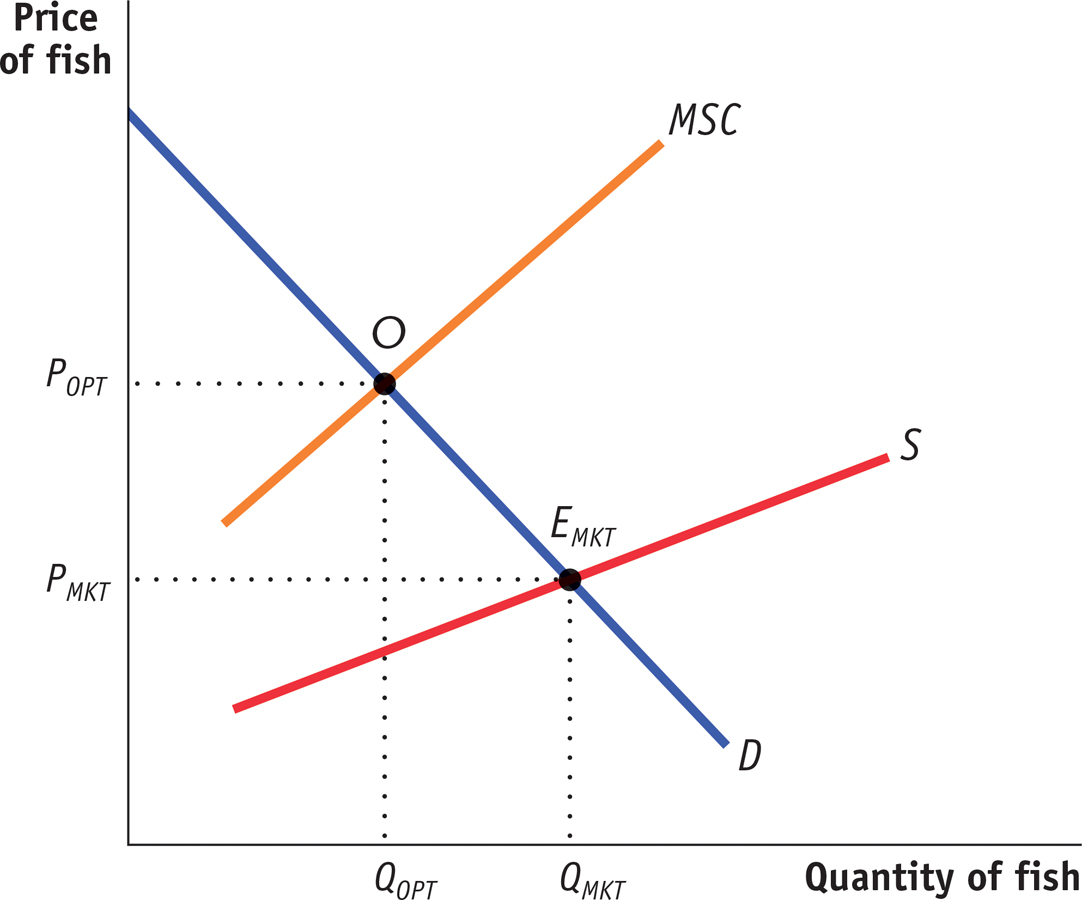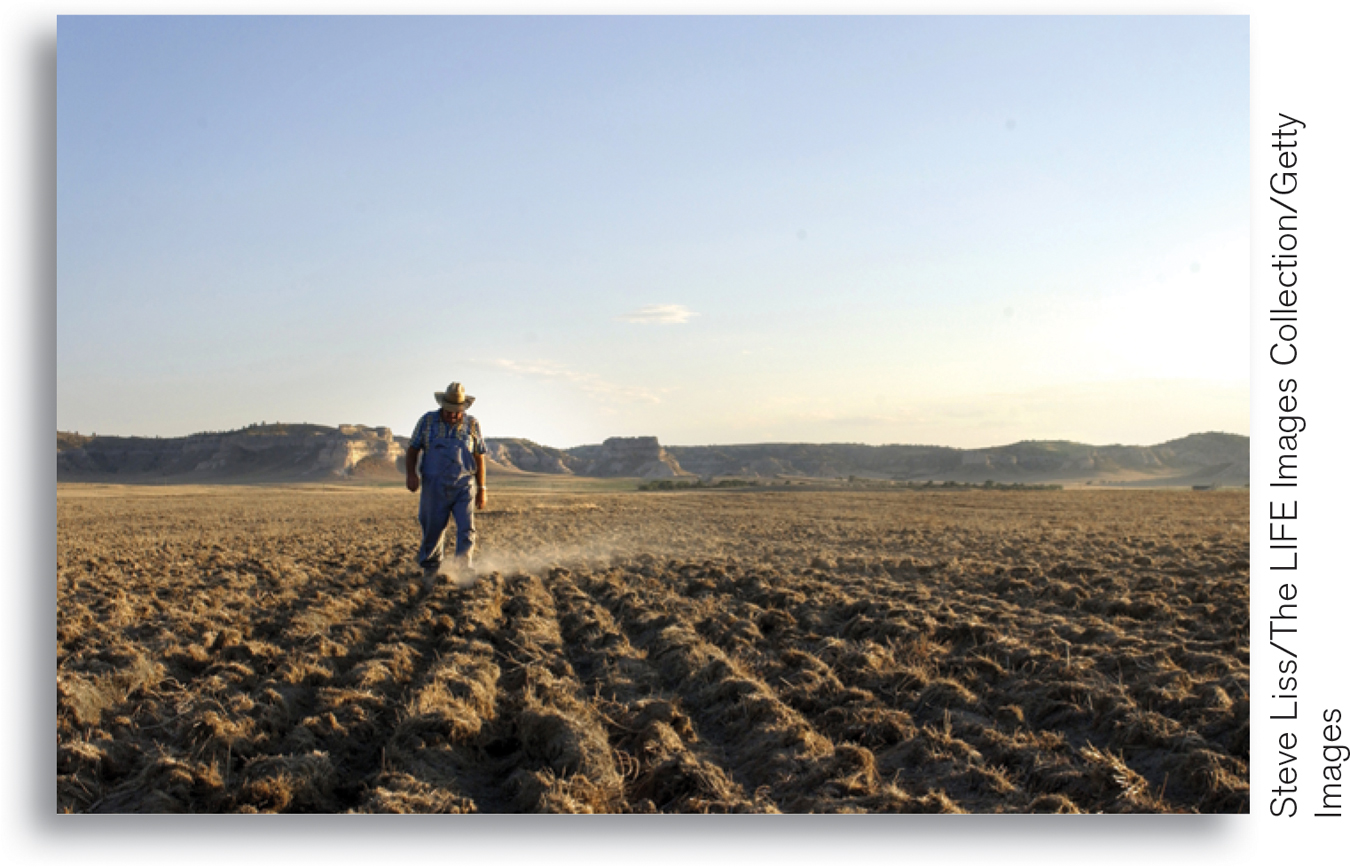Common Resources
A common resource is nonexcludable and rival in consumption: you can’t stop me from consuming the good, and more consumption by me means less of the good available for you.
A common resource is a good that is nonexcludable but is rival in consumption. An example is the stock of fish in a limited fishing area, like the fisheries off the coast of New England. Traditionally, anyone who had a boat could go out to sea and catch fish—
Other examples of common resources are clean air and water as well as the diversity of animal and plant species on the planet (biodiversity). In each of these cases the fact that the good, though rival in consumption, is nonexcludable poses a serious problem.
The Problem of Overuse
Common resources left to the market suffer from overuse: individuals ignore the fact that their use depletes the amount of the resource remaining for others.
Because common resources are nonexcludable, individuals cannot be charged for their use. Yet because they are rival in consumption, an individual who uses a unit depletes the resource by making that unit unavailable to others. As a result, a common resource is subject to overuse: an individual will continue to use it until his or her marginal benefit of its use is equal to his or her own individual marginal cost, ignoring the cost that this action inflicts on society as a whole. As we will see shortly, the problem of overuse of a common resource is similar to a problem we studied in Chapter 16: the problem of a good that generates a negative externality, such as ground-
Fishing is a classic example of a common resource. In heavily fished waters, my fishing imposes a cost on others by reducing the fish population and making it harder for others to catch fish. But I have no personal incentive to take this cost into account, since I cannot be charged for fishing. As a result, from society’s point of view, I catch too many fish.
Traffic congestion is another example of overuse of a common resource. A major highway during rush hour can accommodate only a certain number of vehicles per hour. If I decide to drive to work alone rather than carpool or work at home, I make the commute of many other people a bit longer; but I have no incentive to take these consequences into account.
In the case of a common resource, the marginal social cost of my use of that resource is higher than my individual marginal cost, the cost to me of using an additional unit of the good.
Figure 17-3 illustrates the point. It shows the demand curve for fish, which measures the marginal benefit of fish—
17-3
A Common Resource

But the efficient outcome is to catch the quantity QOPT, the quantity of output that equates the marginal benefit to the marginal social cost, not to the fishing industry’s marginal cost of production. The market outcome results in overuse of the common resource.
As we noted, there is a close parallel between the problem of managing a common resource and the problem posed by negative externalities. In the case of an activity that generates a negative externality, the marginal social cost of production is greater than the industry’s marginal cost of production, the difference being the marginal external cost imposed on society. Here, the loss to society arising from a fisherman’s depletion of the common resource plays the same role as the external cost plays when there is a negative externality. In fact, many negative externalities (such as pollution) can be thought of as involving common resources (such as clean air).
When Fertile Farmland Turned to Dust
Ashley Yost’s grandfather sank a well deep underneath his prime Kansas farmland and struck a source of water so bountiful that he could pump 1,600 gallons to the surface every minute. Now fifty years later, his grandson is having trouble getting just 300 gallons of water per minute. And that water is so contaminated by sediment that tens of thousands of dollars worth of pumping equipment has been destroyed. As Mr. Yost ruefully remarked, “That’s prime land. I’ve raised 294 bushels of corn an acre before.... Now, it’s over.” In west-
This is the sad consequence of mismanagement of a remarkable common resource, the Ogallala Aquifer, one of the world’s largest underground reservoirs of water. It stretches across portions of eight Great Plains states and underlies approximately 174,000 square miles, supplying drinking water for millions of people. The water in the Ogallala Aquifer was deposited 2 to 6 million years ago when the Great Plains region was geologically active. As you might guess, water that was deposited millions of years ago cannot be replenished quickly. For the many parts of the Ogallala that are now dry, it would take over 100,000 years of rainfall to fill them back up.

How did this happen? The decimation of the Ogallala began in the 1950s with the large scale irrigation of Plains farmland with groundwater. The virtually unrestricted pumping of groundwater turned millions of acres of the semi-
While some areas in the northern Plains states still have enough ground-
Some farmers have given up all together, while others have switched to less thirsty crops or to livestock farming. Towns, industries, and recreation activities have all been affected. In Kansas, the state legislature has adopted a new set of water use regulations to encourage conservation, but, at the time of writing it is too early to determine their effectiveness. What we do know is that the days of ignoring a common resource like the Ogallala are over.
The Efficient Use and Maintenance of a Common Resource
Because common resources pose problems similar to those created by negative externalities, the solutions are also similar. To ensure efficient use of a common resource, society must find a way of getting individual users of the resource to take into account the costs they impose on other users. This is basically the same principle as that of getting individuals to internalize a negative externality that arises from their actions.
There are three fundamental ways to induce people who use common resources to internalize the costs they impose on others.
Tax or otherwise regulate the use of the common resource
Create a system of tradable licenses for the right to use the common resource
Make the common resource excludable and assign property rights to some individuals
Like activities that generate negative externalities, use of a common resource can be reduced to the efficient quantity by imposing a Pigouvian tax. For example, some countries have imposed “congestion charges” on those who drive during rush hour, in effect charging them for use of the common resource of city streets. Likewise, visitors to national parks must pay a fee, and the number of visitors to any one park is restricted.
A second way to correct the problem of overuse is to create a system of tradable licenses for the use of the common resource much like the systems designed to address negative externalities. The policy maker issues the number of licenses that corresponds to the efficient level of use of the good. Making the licenses tradable ensures that the right to use the good is allocated efficiently—
But when it comes to common resources, often the most natural solution is simply to assign property rights. At a fundamental level, common resources are subject to overuse because nobody owns them. The essence of ownership of a good—
When a good is nonexcludable, in a very real sense no one owns it because a property right cannot be enforced—
As the following Economics in Action shows, a system of tradable licenses, called individual transferable quotas or ITQs, has been a successful strategy in some fisheries.
!worldview! ECONOMICS in Action: Saving the Oceans with ITQs
Saving the Oceans with ITQs
The world’s oceans are in serious trouble. According to a study by the International Program on the State of the Oceans, there is an imminent risk of widespread extinctions of multiple species of fish. In Europe, 30% of the fish stocks are in danger of collapse. In the North Sea, 93% of cod are fished before they can breed. And bluefin tuna, a favorite in Japanese sushi, are in danger of imminent extinction.
Not surprisingly, the principal culprit is overfishing. The decline of fishing stocks has worsened as fishermen trawl in deeper waters with their very large nets to catch the remaining fish, unintentionally killing many other marine animals in the process.
The fishing industry is in crisis, too, as fishermen’s incomes decline and they are compelled to fish for longer periods of time and in more dangerous waters in order to make a living.

But, individual transferable quotas, or ITQs, may provide a solution to both crises. Under an ITQ scheme, a fisherman receives a license entitling him to catch an annual quota within a given fishing ground. The ITQ is given for a long period of time, sometimes indefinitely. Because it is transferable, the owner can sell or lease it.
Researchers who analyzed 121 established ITQ schemes around the world concluded that ITQs can help reverse the collapse of fisheries because each ITQ holder now has a financial interest in the long-
ITQ schemes (also called catch-
Quick Review
A common resource is rival in consumption but nonexcludable.
The problem with common resources is overuse: a user depletes the amount of the common resource available to others but does not take this cost into account when deciding how much to use the common resource.
Like negative externalities, a common resource can be efficiently managed by Pigouvian taxes, by the creation of a system of tradable licenses for its use, or by making it excludable and assigning property rights.
17-3
Question 17.4
Rocky Mountain Forest is a government-
owned forest in which private citizens were allowed in the past to harvest as much timber as they wanted free of charge. State in economic terms why this is problematic from society’s point of view. When individuals are allowed to harvest freely, the government-owned forest becomes a common resource, and individuals will overuse it—they will harvest more trees than is efficient. In economic terms, the marginal social cost of harvesting a tree is greater than a private logger’s individual marginal cost.
Question 17.5
You are the new forest service commissioner and have been instructed to come up with ways to preserve the forest for the general public. Name three different methods you could use to maintain the efficient level of tree harvesting and explain how each would work. For each method, what information would you need to know in order to achieve an efficient outcome?
The three methods consistent with economic theory are (i) Pigouvian taxes, (ii) a system of tradable licenses, and (iii) allocation of property rights.
- Pigouvian taxes. You would enforce a tax on loggers that equals the difference between the marginal social cost and the individual marginal cost of logging a tree at the socially efficient harvest amount. In order to do this, you must know the marginal social cost schedule and the individual marginal cost schedule.
- System of tradable licenses. You would issue tradable licenses, setting the total number of trees harvested equal to the socially efficient harvest number. The market that arises in these licenses will allocate the right to log efficiently when loggers differ in their costs of logging: licenses will be purchased by those who have a relatively lower cost of logging. The market price of a license will be equal to the difference between the marginal social cost and the individual marginal cost of logging a tree at the socially efficient harvest amount. In order to implement this level, you need to know the socially efficient harvest amount.
- Allocation of property rights. Here you would sell or give the forest to a private party. This party will have the right to exclude others from harvesting trees. Harvesting is now a private good—it is excludable and rival in consumption. As a result, there is no longer any divergence between social and private costs, and the private party will harvest the efficient level of trees. You need no additional information to use this method.
Solutions appear at back of book.